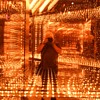Posted 10 years ago
 scottvez
scottvez
(977 items)
These MAMMOTH plate images from the Civil War era or earlier are very rare to find.
The glass plate measures about 11 1/2" X 9 1/2" (whole plate is about 8 1/2" X 6 1/2") and these fragile glass plates were expensive to make in the era and few survived.
The image is housed in a photographers frame and has names on the back that lead to a NH soldier. I am still doing research to confirm the ID.
For those not familiar with the ambrotype, they are a negative photo on glass, that when backed with black turn into a positive image. My third photo shows the glass plate with a white back.
Ambrotypes were contemporary to tintypes but fell out of favor by the end of the Civil War in the US (UK ambrotypes continued on to the end of the century).

























Thanks for looking vrgdc and valentino.
scott
Always wondered why so many of these era pics show the men with a hand under their coats like they are about to have a heart attack or reaching for a weapon?
It is common in 19th century photographs.
Here are some wiki thoughts:
http://en.wikipedia.org/wiki/Hand-in-waistcoat
scott
I wonder if the gals in back are widows? Especially the one on the right.
Hi Scott, take a look at my latest soldier pick. I thought his face was so intense.
Guessing WWI
Helps if I link ya...
http://www.collectorsweekly.com/stories/129698-back-to-finding-photos?in=user
Thanks for looking amber-- posted a comment on your photos as well.
scott
Thanks vo and manikin.
scott
Thanks much for looking gatekeeper.
scott
Hi! scott...great photos!...:-)
Thanks for looking and commenting inky!
scott
Thanks for looking tom.
scott
Updated to reflect actual size. NOT a whole plate-- actually a good bit larger and classified as a MAMMOTH PLATE.
scott
Thanks bhock and cultcha.
scott
Hey Scott ... I saw your note on my Bijou camera posting. Most certainly American Optical, E. & H.T. Anthony, and Scovill companies had cameras large enough for mammoth plates during the civil war years. Later 1870s catalogues list cameras up to 20 x 24 inches in format. Yet the vast majority was studio equipment. However some forms of these 1870s cameras were around in the 1860s. Field cameras were often no larger than 11 x 14 but of course there are exceptions; especially if the photographer set up a portable studio. The largest cameras were often used for making multiple images on a single plate, but as your ambrotype shows larger format images could also be made with these - it’s simply a matter of lenses and formatting masks. And as you point out, most anything bigger than whole-plate is rare and plates often broke. FWIW, mammoth format cameras go back to the dag years (but you probably knew that).
For reference, refer to my post of an American late 1850s to 1860s 11x14 inch field camera that could easily make your image:
http://www.collectorsweekly.com/stories/101272-the-good-old-days-a-huge-1850s-collodi
It’s interesting because this is an example of a small builder that got into the game of making big field cameras.
Thanks for the info rob.
I have seen/ owned a few mammoth plate albumen prints from the Civil War, but this is the first war era "hard image" of that size that I have owned.
I remember seeing an 1870s image of a greenhouse that was glassed with numerous mammoth plate glass plates. I believe that was the fate of a famous photographers original negatives-- don't recall who it was. I think most of Brady's went to the US government in the 1870s.
scott
Glad to help. The discovery and recovery of Brady's original negatives is a fascinating story that was documented by the grandson of the man who acquired them. Most all surviving Brady portrait negatives were purchased in 1902 from Anthony & Scovill (who was reprinting images from the negs ... which included seven Lincoln negatives) by Frederick Hill Meserve. Meserve started his collection in 1897 with a winning bid of $1.10 at an auction by “Bang’s Auction Room”. The win had 100+ salt prints that included original Brady images that were copies of dags. According to Meserve's grandson, many images (including the rare copies of Brady dags) were transferred to the Library of Congress in 1920. I'm unsure where the negatives ended up.
And it's sad that plates were used for windows. Edward Weston cleaned some of his glass plates to replace broken windows.
Most of Brady's Civil War negative (glass plate) archive was purchased by Congress in 1875. I am not sure what portraits were included in that purchase.
scott
Hola tengo una foto muy parecida
Necesito tu ayuda tengo una foto parecida que es un vidrio... De George cook
Glad to help out.
What questions do you have?
scott